Permanently grounded through the removal of its outer wing sections, Emperor Bao Dai’s Morane-Saulnier parasol monoplane was used as a trainer for Vietnamese pilots and mechanics from March 1949 onwards.
When the former Emperor Bao Dai arrived in Hanoi as an advisor to the Democratic Republic of Vietnam after the revolt against the French colonial regime in August 1945, he was the proud owner of two light aircraft.
Dai had been the last Emperor of the Nguyen Dynasty, reigning from 1926 to 1945, when he abdicated in favour of Ho Chi Minh and fled to France. In 1949 he returned from self-imposed exile in Hong Kong to resume his status as emperor under French and American sponsorship. Bao Dai proved less than successful in this new role, however, being corrupt, and still lacking fluency in Vietnamese due to his classical French education.
Despite these failings, he represented acceptable Vietnamese ‘nationalism’ in the eyes of the French and American governments, who vehemently opposed Ho Chi Minh and his Viet Minh communist revolutionaries. Bao Dai remained in power for another four years, before being deposed by the newly-elected Prime Minister of South Vietnam, Ngo Dinh Diem, in 1954 and fleeing to France. He died in Paris in July 1997.
Returning to the emperor’s aircraft, Bao Dai owned a British-built 6 Tiger Moth two-seat biplane trainer and a French Morane-Saulnier parasol monoplane. Both had been owned by French pilots who fled when the revolt began in 1945, leaving the aircraft idle in storage. Bao Dai, who had a taste for a racy and sporty lifestyle, inherited them.
At the end of that year Bao Dai offered the aircraft to the revolutionaries, suggesting they be taken to Hanoi from Hue. The government was keen to accept his offer, and liked the suggestion that they could be used to teach young people to fly. Bao Dai also hoped to have the chance to use them privately. The Ministry of Defence entrusted Phan Phac, head of the Department of Military Training, and a pre-revolutionary French Army veteran, to bring the aircraft north.
Dismantled and shipped to Hanoi by train, the aircraft duly completed their journey by road to an airfield in the Tung Thien district of Son Tay (now Ha Tay province). There, they could be kept out of harm’s way, clear of the larger airfields including Gia Lam, Bach Mai and Cat Bi that had been occupied by the Chinese army, which had entered North Vietnam to disarm the Japanese at the end of World War 2.
In January 1946 the Tiger Moth and Morane-Saulnier reached Tong airfield, accompanied by a maintenance crew headed by mechanic Tran Dong. But the crew encountered problems and the aircraft remained in their packing cases. In December, when the revolt against the French erupted into a full-scale war of national resistance, the little aircraft might have played a part against their former owners. Indeed, it was suggested that the Morane-Saulnier should be used to drop mortars on French forces in Nam Dinh. However, the idea was rejected, and the Joint General Staff were ordered by the revolutionary leaders to take the aircraft to the base at Viet Bac. After a long journey by land and water, they ended up in Chiem Hoa, where a corn field was used as a temporary airstrip.
The aircraft might also have eventually found themselves back in their packing cases had it not been for a decree from Ho Chi Minh himself, Vietnam’s revolutionary leader. On his orders, the Ministry of Defence formed the Air Force Research Committee (Ban Nghien Cuu Khong Quan) on 9 March 1949. The Tiger Moth and Morane-Saulnier became valuable trainers for pilots and mechanics.
Nguyen Due Viet was among the first officers assigned to the committee. He was a soldier of German nationality (his mother was German and his father Vietnamese, and he grew up in Germany) who had served in the French Legion Etrangere, the famed and feared Foreign Legion. Viet had switched his allegiance to the revolutionary fighters in the early days of the conflict in Trung Bo (central Vietnam).
On the afternoon of 15 August 1949, Viet prepared for a flight in the Tiger Moth, and took off smoothly from Son Dung sand bar beside the Gam River, with mechanic Tran Dong as his passenger. The aircraft reached an altitude of more than 3000 ft, but developed mechanical problems during the descent. Only Viet’s skill saved their lives.
The aircraft was a write-off, but that mattered little, for the flight was to go down in history as the first time a Vietnamese aircraft, bearing the Vietnamese insignia, had flown in the free air space of the Democratic Republic of Vietnam.
